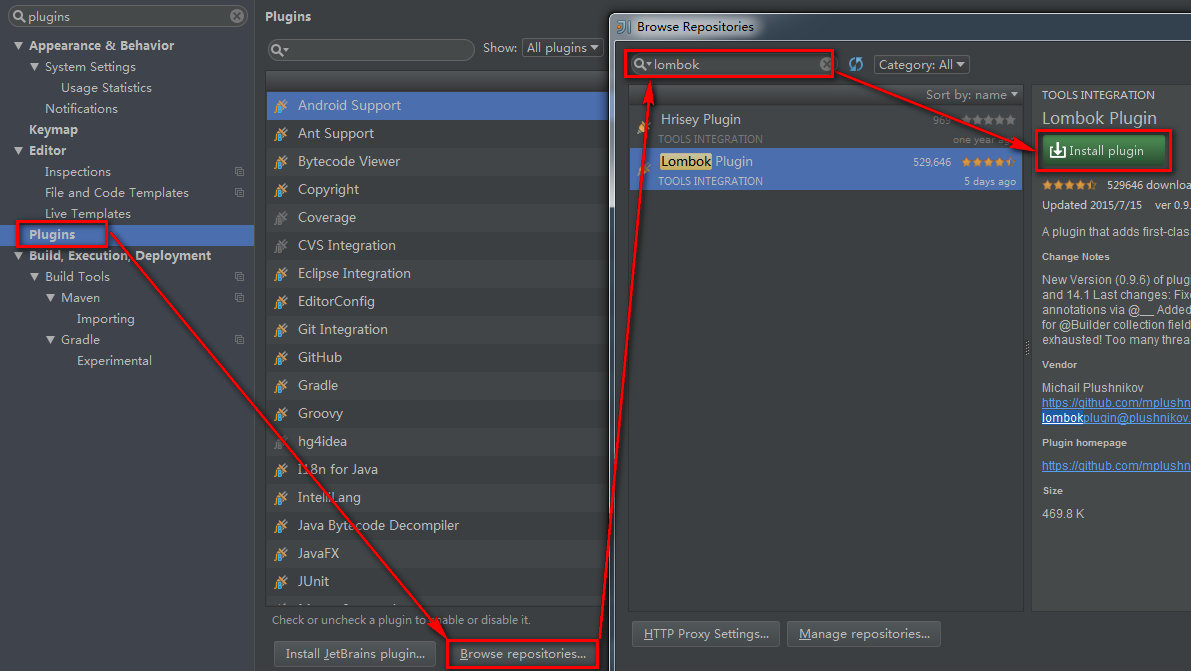十分鐘搞懂Lombok使用與原理
1 簡介
Lombok是一款好用順手的工具,就像Google Guava一樣,在此予以強烈推薦,每一個Java工程師都應該使用它。Lombok是一種Java™實用工具,可用來幫助開發人員消除Java的冗長程式碼,尤其是對於簡單的Java物件(POJO)。它通過註釋實現這一目的。通過在開發環境中實現Lombok,開發人員可以節省構建諸如hashCode()和equals()這樣的方法以及以往用來分類各種accessor和mutator的大量時間。
2 IntelliJ安裝Lombok
通過IntelliJ的外掛中心安裝

Install Plugin

最後需要注意的是,在使用lombok註解的時候記得要匯入lombok.jar包到工程,如果使用的是Maven Project,要在pom.xml中新增依賴。
<dependency>
<groupId>org.projectlombok</groupId>
<artifactId>lombok</artifactId>
<version>1.16.8</version>
</dependency>3 Lombok用法
3.1 Lombok註解說明
val:用在區域性變數前面,相當於將變數宣告為final@NonNull:給方法引數增加這個註解會自動在方法內對該引數進行是否為空的校驗,如果為空,則丟擲NPE(NullPointerException)@Cleanup:自動管理資源,用在區域性變數之前,在當前變數範圍內即將執行完畢退出之前會自動清理資源,自動生成try-finally這樣的程式碼來關閉流@Getter/@Setter:用在屬性上,再也不用自己手寫setter和getter方法了,還可以指定訪問範圍@ToString:用在類上,可以自動覆寫toString方法,當然還可以加其他引數,例如@ToString(exclude=”id”)排除id屬性,或者@ToString(callSuper=true, includeFieldNames=true)呼叫父類的toString方法,包含所有屬性@EqualsAndHashCode:用在類上,自動生成equals方法和hashCode方法@NoArgsConstructor, @RequiredArgsConstructor and @AllArgsConstructor:用在類上,自動生成無參構造和使用所有引數的建構函式以及把所有@NonNull屬性作為引數的建構函式,如果指定staticName = “of”引數,同時還會生成一個返回類物件的靜態工廠方法,比使用建構函式方便很多@Data:註解在類上,相當於同時使用了@ToString、@EqualsAndHashCode、@Getter、@Setter和@RequiredArgsConstrutor這些註解,對於POJO類十分有用@Value:用在類上,是@Data的不可變形式,相當於為屬性新增final宣告,只提供getter方法,而不提供setter方法@Builder:用在類、構造器、方法上,為你提供複雜的builder APIs,讓你可以像如下方式一樣呼叫Person.builder().name("Adam Savage").city("San Francisco").job("Mythbusters").job("Unchained Reaction").build();更多說明參考Builder@SneakyThrows:自動拋受檢異常,而無需顯式在方法上使用throws語句@Synchronized:用在方法上,將方法宣告為同步的,並自動加鎖,而鎖物件是一個私有的屬性$lock或$LOCK,而java中的synchronized關鍵字鎖物件是this,鎖在this或者自己的類物件上存在副作用,就是你不能阻止非受控程式碼去鎖this或者類物件,這可能會導致競爭條件或者其它執行緒錯誤@Getter(lazy=true):可以替代經典的Double Check Lock樣板程式碼@Log:根據不同的註解生成不同型別的log物件,但是例項名稱都是log,有六種可選實現類
@CommonsLogCreates log = org.apache.commons.logging.LogFactory.getLog(LogExample.class);@LogCreates log = java.util.logging.Logger.getLogger(LogExample.class.getName());@Log4jCreates log = org.apache.log4j.Logger.getLogger(LogExample.class);@Log4j2Creates log = org.apache.logging.log4j.LogManager.getLogger(LogExample.class);@Slf4jCreates log = org.slf4j.LoggerFactory.getLogger(LogExample.class);@XSlf4jCreates log = org.slf4j.ext.XLoggerFactory.getXLogger(LogExample.class);
3.2 Lombok程式碼示例
- val示例
public static void main(String[] args) {
val sets = new HashSet<String>();
val lists = new ArrayList<String>();
val maps = new HashMap<String, String>();
//=>相當於如下
final Set<String> sets2 = new HashSet<>();
final List<String> lists2 = new ArrayList<>();
final Map<String, String> maps2 = new HashMap<>();
}- @NonNull示例
public void notNullExample(@NonNull String string) {
string.length();
}
//=>相當於
public void notNullExample(String string) {
if (string != null) {
string.length();
} else {
throw new NullPointerException("null");
}
}- @Cleanup示例
public static void main(String[] args) {
try {
@Cleanup InputStream inputStream = new FileInputStream(args[0]);
} catch (FileNotFoundException e) {
e.printStackTrace();
}
//=>相當於
InputStream inputStream = null;
try {
inputStream = new FileInputStream(args[0]);
} catch (FileNotFoundException e) {
e.printStackTrace();
} finally {
if (inputStream != null) {
try {
inputStream.close();
} catch (IOException e) {
e.printStackTrace();
}
}
}
}- @Getter/@Setter示例
@Setter(AccessLevel.PUBLIC)
@Getter(AccessLevel.PROTECTED)
private int id;
private String shap;- @ToString示例
@ToString(exclude = "id", callSuper = true, includeFieldNames = true)
public class LombokDemo {
private int id;
private String name;
private int age;
public static void main(String[] args) {
//輸出LombokDemo(super=LombokDemo@48524010, name=null, age=0)
System.out.println(new LombokDemo());
}
}- @EqualsAndHashCode示例
@EqualsAndHashCode(exclude = {"id", "shape"}, callSuper = false)
public class LombokDemo {
private int id;
private String shap;
}- @NoArgsConstructor, @RequiredArgsConstructor and @AllArgsConstructor示例
@NoArgsConstructor
@RequiredArgsConstructor(staticName = "of")
@AllArgsConstructor
public class LombokDemo {
@NonNull
private int id;
@NonNull
private String shap;
private int age;
public static void main(String[] args) {
new LombokDemo(1, "circle");
//使用靜態工廠方法
LombokDemo.of(2, "circle");
//無參構造
new LombokDemo();
//包含所有引數
new LombokDemo(1, "circle", 2);
}
}- @Data示例
import lombok.Data;
@Data
public class Menu {
private String shopId;
private String skuMenuId;
private String skuName;
private String normalizeSkuName;
private String dishMenuId;
private String dishName;
private String dishNum;
//預設閾值
private float thresHold = 0;
//新閾值
private float newThresHold = 0;
//總得分
private float totalScore = 0;
}- @Value示例
@Value
public class LombokDemo {
@NonNull
private int id;
@NonNull
private String shap;
private int age;
//相當於
private final int id;
public int getId() {
return this.id;
}
...
}- @Builder示例
@Builder
public class BuilderExample {
private String name;
private int age;
@Singular
private Set<String> occupations;
public static void main(String[] args) {
BuilderExample test = BuilderExample.builder().age(11).name("test").build();
}
}- @SneakyThrows示例
import lombok.SneakyThrows;
import java.io.FileInputStream;
import java.io.FileNotFoundException;
import java.io.InputStream;
import java.io.UnsupportedEncodingException;
public class Test {
@SneakyThrows()
public void read() {
InputStream inputStream = new FileInputStream("");
}
@SneakyThrows
public void write() {
throw new UnsupportedEncodingException();
}
//相當於
public void read() throws FileNotFoundException {
InputStream inputStream = new FileInputStream("");
}
public void write() throws UnsupportedEncodingException {
throw new UnsupportedEncodingException();
}
}- @Synchronized示例
public class SynchronizedDemo {
@Synchronized
public static void hello() {
System.out.println("world");
}
//相當於
private static final Object $LOCK = new Object[0];
public static void hello() {
synchronized ($LOCK) {
System.out.println("world");
}
}
}- @Getter(lazy = true)
public class GetterLazyExample {
@Getter(lazy = true)
private final double[] cached = expensive();
private double[] expensive() {
double[] result = new double[1000000];
for (int i = 0; i < result.length; i++) {
result[i] = Math.asin(i);
}
return result;
}
}
// 相當於如下所示:
import java.util.concurrent.atomic.AtomicReference;
public class GetterLazyExample {
private final AtomicReference<java.lang.Object> cached = new AtomicReference<>();
public double[] getCached() {
java.lang.Object value = this.cached.get();
if (value == null) {
synchronized (this.cached) {
value = this.cached.get();
if (value == null) {
final double[] actualValue = expensive();
value = actualValue == null ? this.cached : actualValue;
this.cached.set(value);
}
}
}
return (double[]) (value == this.cached ? null : value);
}
private double[] expensive() {
double[] result = new double[1000000];
for (int i = 0; i < result.length; i++) {
result[i] = Math.asin(i);
}
return result;
}
}4 Lombok註解原理
說道 Lombok,我們就得去提到 JSR 269: Pluggable Annotation Processing API (www.jcp.org/en/jsr/deta…) 。JSR 269 之前我們也有註解這樣的神器,可是我們比如想要做什麼必須使用反射,反射的方法侷限性較大。首先,它必須定義@Retention為RetentionPolicy.RUNTIME,只能在執行時通過反射來獲取註解值,使得執行時程式碼效率降低。其次,如果想在編譯階段利用註解來進行一些檢查,對使用者的某些不合理程式碼給出錯誤報告,反射的使用方法就無能為力了。而 JSR 269 之後我們可以在 Javac的編譯期利用註解做這些事情。所以我們發現核心的區分是在 執行期 還是 編譯期。

從上圖可知,Annotation Processing 是在解析和生成之間的一個步驟。具體詳細步驟如下:

上圖是 Lombok 處理流程,在Javac 解析成抽象語法樹之後(AST), Lombok 根據自己的註解處理器,動態的修改 AST,增加新的節點(所謂程式碼),最終通過分析和生成位元組碼。
自從Java 6起,javac就支援“JSR 269 Pluggable Annotation Processing API”規範,只要程式實現了該API,就能在javac執行的時候得到呼叫。
- 常用的專案管理工具Maven所使用的java編譯工具來源於配置的第三方工具,如果我們配置這個第三方工具為Oracle javac的話,那麼Maven也就直接支援lombok了;
- Intellij Idea配置的編譯工具為Oracle javac的話,也就直接支援lombok了;
IDE工具問題解決:
現在有一個A類,其中有一些欄位,沒有建立它們的setter和getter方法,使用了lombok的@Data註解,另外有一個B類,它呼叫了A類例項的相應欄位的setter和getter方法
編譯A類和B類所在的專案,並不會報錯,因為最終生成的A類位元組碼檔案中存在相應欄位的setter和getter方法
但是,IDE發現B類原始碼中所使用的A類例項的setter和getter方法在A類原始碼中找不到定義,IDE會認為這是錯誤
要解決以上這個不是真正錯誤的錯誤,可以下載安裝Intellij Idea中的"Lombok plugin"。
5 自定義支援JSR269的註解
一般javac的編譯過程,java檔案首先通過進行解析構建出一個AST,然後執行註解處理,最後經過分析優化生成二進位制的.class檔案。我們能做到的是,在註解處理階段進行一些相應處理。首先我們在META-INF.services下建立如下檔案:

檔案中指定我們的註解處理器:com.alipay.kris.other.lombok.MyAnnotaionProcessor,然後我們接可以編寫自己的註解處理器,一個簡單的例項程式碼如下:
@SupportedSourceVersion(SourceVersion.RELEASE_8)
@SupportedAnnotationTypes("com.alipay.kris.other.lombok.*")
public class MyAnnotaionProcessor extends AbstractProcessor {
public MyAnnotaionProcessor() {
super();
}
@Override
public boolean process(Set<? extends TypeElement> annotations,RoundEnvironment roundEnv) {
for (Element elem : roundEnv.getElementsAnnotatedWith(MyAnnotation.class)) {
MyAnnotation annotation = elem.getAnnotation(MyAnnotation.class);
String message = "annotation found in " + elem.getSimpleName()
+ " with " + annotation.value();
addToString(elem);
processingEnv.getMessager().printMessage(Diagnostic.Kind.NOTE, message);
}
return true; // no further processing of this annotation type
}
}
